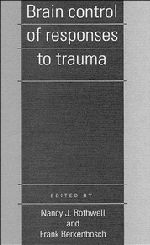Book contents
- Frontmatter
- Contents
- Contributors
- 1 Introduction
- 2 Responses to injury
- 3 Experimental approaches to the central nervous system control of responses to trauma
- 4 Neurohormonal control of cytokines during injury
- 5 Brain regions involved in modulation of immune responses
- 6 Psychological and neurobiological consequences of trauma
- 7 Central nervous system control of sickness behavior
- 8 Psychological and behavioural aspects of pain
- 9 Central control of cardiovascular responses to injury
- 10 Neuroendocrine responses to physical trauma
- 11 Central control of metabolic and thermoregulatory responses to injury
- 12 Central control of pain
- 13 The final word …
- Index
11 - Central control of metabolic and thermoregulatory responses to injury
Published online by Cambridge University Press: 05 August 2016
- Frontmatter
- Contents
- Contributors
- 1 Introduction
- 2 Responses to injury
- 3 Experimental approaches to the central nervous system control of responses to trauma
- 4 Neurohormonal control of cytokines during injury
- 5 Brain regions involved in modulation of immune responses
- 6 Psychological and neurobiological consequences of trauma
- 7 Central nervous system control of sickness behavior
- 8 Psychological and behavioural aspects of pain
- 9 Central control of cardiovascular responses to injury
- 10 Neuroendocrine responses to physical trauma
- 11 Central control of metabolic and thermoregulatory responses to injury
- 12 Central control of pain
- 13 The final word …
- Index
Summary
Introduction
Changes in body temperature and metabolism (energy and substrate metabolism) are common features of many disease states, and have been well documented following various forms of tissue injury. Body temperature is a precisely regulated phenomenon such that core temperature (most probably brain temperature) is normally maintained within a narrow range by physiological controls operating on heat loss and heat production (metabolic rate). In contrast, energy metabolism is highly variable, depending on the balance between energy intake and expenditure (heat production and physical work). Nevertheless, there is extensive evidence that this balance between energy input and output remains remarkably constant over long periods of time in many organisms, including humans. Thus total body energy content, mainly in the form of fat and protein, can be stable for months or even years. The physiological regulation of body temperature and energy metabolism, which are both under direct control of the central nervous system (CNS), are closely related. The regulation of core temperature is achieved by controls operating on heat loss and heat production, with the latter predominating in many situations. Thus, development of fever is almost always associated with increased rates of heat production and, if sustained, these will lead to depletion of body energy stores and weight loss which are confounded by reduced levels of food intake. In contrast, increased heat production, if not fully compensated by enhanced heat loss, will lead to a rise in body temperature, although this does not necessarily manifest itself as ‘fever’ according to strict physiological definition.
For these reasons, the central control of body temperature and the metabolic rate response to injury will be considered in parallel. Alterations in specific nutrient metabolism (e.g. protein and lipid metabolism) following injury are numerous and complex, and will therefore not be reviewed in detail, although it is obvious that these both influence and are directly dependent on variations in core temperature and metabolic rate.
Basic aspects of thermoregulation and metabolic rate - definitions and measurement
Body temperature is most reliably determined from measurements of deep core temperature, i.e. gut or brain temperature. Rectal temperature can provide a reliable index of this parameter but is sometimes inconvenient, while oral temperature may be unreliable. In experimental animals, core temperature is usually determined by insertion of a thermocouple beyond the rectal sphincter into the colon.
- Type
- Chapter
- Information
- Brain Control of Responses to Trauma , pp. 260 - 294Publisher: Cambridge University PressPrint publication year: 1994



